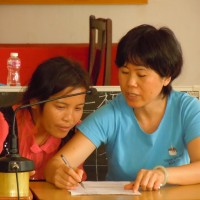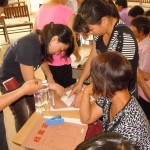
CHICAPS (Chinese Cervical Cancer Prevention Study)
Over the past several years the focus of cervical cancer screening programs designed for mass screening and able to reach the underserved, have ranged from complex infrastructure demanding cytology (Pap) based efforts, to very low tech unaided visual inspection programs (using 5% acetic acid). Then molecular testing (detection of high-risk HPV) moved to center stage with increased sensitivity and an excellent negative predictive value. Now with the development of relatively low-cost, low tech, rapid (2hr, 20-90 batch) HPV testing (CareHPV), algorithms are being developed to try to deliver care to the underserved. Due to recent findings based on our self-sampling work over the past 16 years, recent developments in solid transport media (specimen transport cards), and our enlightening experience (in SHENCCAST II) with a low cost, high throughput, high tech HPV testing system, we have designed this study to further explore these technologies and their cost-effective implementation for world-wide cervical cancer control. CHICAPS builds upon the work we have been doing in the PERCAPS project in Peru
The Primary Objective
1. To develop and implement a community based model for cervical cancer prevention that allows the communities to manage the screening and the healthcare system to focus resources on evaluation and management of the positives.
Method: Using self-sampling and the concepts founded in Community Based Participatory Research (CBPR), we progressively developed a model to efficiently reach the women, especially rural communities; and collect the volume of samples needed to support high throughput centralized low cost per case processing
Results: 8382 eligible women, ages 35 to 59, in 130 rural communities participated. The screening was organized by the local government administration and conducted by the community leaders (CL). The model used was progressively designed through detailed assessment of key elements at 6 decision points in 26 workshops that were used to train the CLs and the local promoters. The communities were able to accurately conduct the screening; in the final model a local medical worker conducted a 50-minute workshop featuring instructional posters and structured role-play. A manual and a workshop DVD were created for distribution to and implementation by local governments. The average callback rate was 84.3%, without involvement of the local doctors in the management of the positives.
Conclusion: An efficient community based model capable of massive screening events was developed. We believe the callback rate will be further improved when local doctors are trained in the management of the positives. Many elements impact coverage and further research is needed to define the influence of the identified key variables.
Secondary Objectives
1. Acquire increased experience using solid transport media cards with the rapid high risk PCR based HPV assay using Mass Spectrometry (MALDI-TOF) in a cervical cancer screening program.
- 2. Development of an effective specimen transport system (air, truck, etc).
3. Determine the true impact of histopathological verification of disease in the screen, triage, and treat model. As of this writing we have just began the 2 year follow-up which includes the evaluation (at 6 months and 2 years) of a randomization for evaluation and management.
Photos
Please click on any image to zoom, then use < > or arrow keys to navigate.












